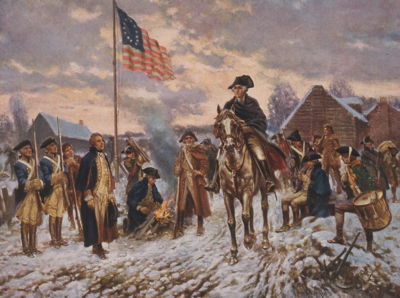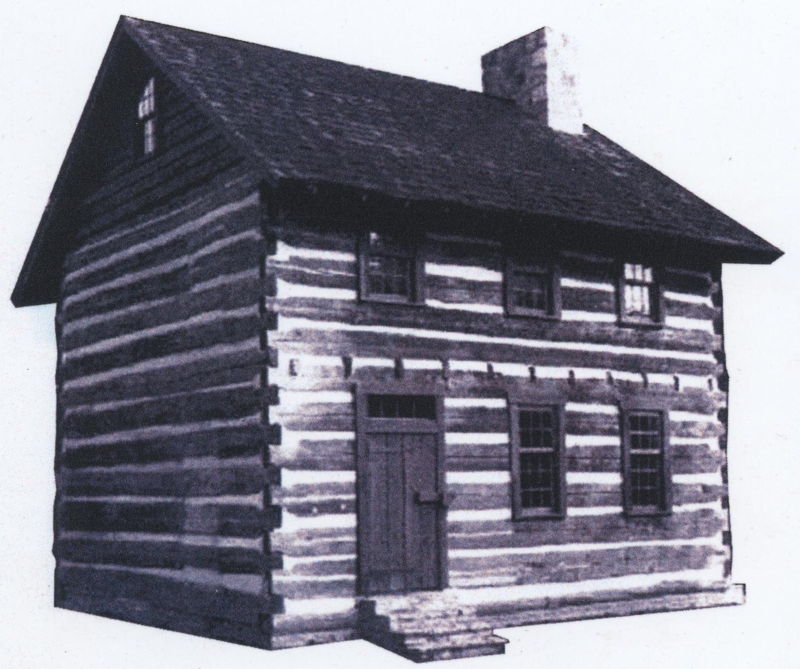
The following article by David Strange appeared in The Courier-Journal on 21 Dec 2014. It is archived here with additional information for your reading enjoyment.
Last week, I wrote about the snowstorm of 1994.
This time, let me tell you a little more about the vicious winters of 1777-1780.

The winter of 1777/78 is one that every American knows a little about. On December 17, 1777, the Continental Army led by George Washington set up winter quarters at Valley Forge, Pennsylvania. During that horrible winter encampment, nearly 2500 American soldiers died of starvation, disease, malnutrition, and exposure. The endurance of the army that winter, and its emergence as a fighting force the following spring, is one of the key moments in the American Revolution for Independence.
What you might not know is that the following two winters were actually worse weather, though the army was better prepared for those. And you might not know how that connects to Bullitt County area history, over 700 miles away.
The Kentucky wilderness shared the same record-cold winters as the northeast during the Revolution, but in 1777 there were only a few hundred pioneer settlers in the entire region. In 1777 there were only three Kentucky settlements; those being Harrodsburg, Boonesboro, and Logan's Station, and those only about three years in existence. There was yet no Louisville, no Lexington.
But in the spring of 1778 an encampment was placed on Corn Island, and in fall of that year, a small fort was built on the north shore of the Ohio River that would someday become the city of Louisville. At about the same time, small bands of adventurers followed buffalo trails out into the wild country of what would become Bullitt County, and built settlements at Bullitt's Lick and Brashear's Station.
For now the tentative little settlements had to focus more on surviving, rather than any revolutionary war, for the settlements had been founded at a time of the worst winters of the 17 & 1800's. Nature made clear who was in charge, with deadly cold weather and deep, icy snow.
Historians say that the winters of 1778 and '79 were actually harder winters that the '77 winter at Valley Forge. NOAA records say that in 1779/80 the winter was so cold that ice piled up 20' high on the Delmarva Coast. Waterways in Virginia were frozen solid enough to support the crossing of Virginia infantry fighting in the Revolution, actually creating opportunity for important surprise winter victories.

In the Bullitt County, Kentucky, area, tiny cabins of settlers tried to hold on through the bitter cold, hundreds of miles from any possible help. It is recorded that wolves came boldly right into the camps and took down grown cows. It was so cold that buffalo, still plentiful in the area, pushed against the tiny cabins seeking the warmth inside, threatening to collapse the buildings. In late 1779, Indian attacks and winter cold forced the evacuation of Bullitts Lick.
But spring did come. The salt makers were back in 1780, and never left after that, despite another severe winter in 1780/81.
New settlements began at Mud Garrison and Dowdall's Station along the Salt River. By 1788, Benjamin Pope had built the first house in Bullitt County outside of a fort, across the Salt River from Dowdall's Station. Portions of that house still remain today, preserved by Marylyn and Gary Lee family.
I have not read what Christmas night was like at Valley Forge or at the fledgling settlements scattered at Bullitts Lick, Brashear's Station, and those few other lonely outposts so long ago. The concept of being so very far away from everyone and everything is hard to imagine, even in snowstorms like our own in 1994. Yet, there is a bond in the chill of the bone; at least a small understanding of what pioneers went through, when one feels the isolation of a long, hard winter.
Copyright 2014 by David Strange, Shepherdsville KY. All rights are reserved. No part of the content of this page may be included in any format in any place without the written permission of the copyright holder.
The Bullitt County History Museum, a service of the Bullitt County Genealogical Society, is located in the county courthouse at 300 South Buckman Street (Highway 61) in Shepherdsville, Kentucky. The museum, along with its research room, is open 10 a.m. to 4 p.m. Monday through Friday. Saturday appointments are available by calling 502-921-0161 during our regular weekday hours. Admission is free. The museum, as part of the Bullitt County Genealogical Society, is a 501(c)3 tax exempt organization and is classified as a 509(a)2 public charity. Contributions and bequests are deductible under section 2055, 2106, or 2522 of the Internal Revenue Code. Page last modified: 12 Sep 2024 . Page URL: